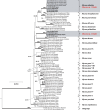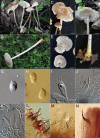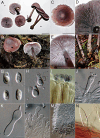Two new Mycena section Calodontes species: One newly discovered and the other new to Japan
- PMID: 39233757
- PMCID: PMC11369303
- DOI: 10.47371/mycosci.2024.02.002
Two new Mycena section Calodontes species: One newly discovered and the other new to Japan
Abstract
In 2017, two candidate species of Mycena were reported from Japan, with the Japanese names "Togari-sakura-take" and "Mitsuhida-sakura-take". However, to date, no taxonomic study or formal description has been undertaken for these two species. In the present study, we conducted comprehensive morphological and molecular phylogenetic examinations of "Togari-sakura-take" and "Mitsuhida-sakura-take", and compared them to known species within the genus Mycena. We performed phylogenetic analyses on a concatenated dataset, including the internal transcribed spacer region of ribosomal RNA, RNA polymerase II largest subunit, and translation elongation factor-1 alpha genes. "Togari-sakura-take" formed a clade with Mycena subulata, which was recently described from China, whereas "Mitsuhida-sakura-take" formed a distinct independent clade. We identified the former as M. subulata based on molecular phylogenetic analyses and morphological observations. However, the Japanese specimens displayed dextrinoid cheilocystidia and caulocystidia as well as the inamyloidity of basidiospores, which differed from the original description of M. subulata based on the materials from China. "Mitsuhida-sakura-take" was characterized by its remarkably dense lamellae and could be distinguished from known Mycena species by the combination of absent pleurocystidia and presence of bowling pin-shaped cheilocystidia. Here, we describe "Mitsuhida-sakura-take" as a new species, named Mycena densilamellata, in the section Calodontes.
Keywords: 1 new taxon; Mycenaceae; molecular phylogeny; morphology; new to Japan.
2024, by The Mycological Society of Japan.
Figures




Similar articles
-
New Species of Bioluminescent Mycena Sect. Calodontes (Agaricales, Mycenaceae) from Mexico.J Fungi (Basel). 2023 Sep 1;9(9):902. doi: 10.3390/jof9090902. J Fungi (Basel). 2023. PMID: 37755010 Free PMC article.
-
Mycenabrunnescens (Basidiomycota, Mycenaceae), a new species of Mycena sect. Pterigenae from China.Biodivers Data J. 2024 Jul 25;12:e125570. doi: 10.3897/BDJ.12.e125570. eCollection 2024. Biodivers Data J. 2024. PMID: 39099603 Free PMC article.
-
Four new species of Mycenasect.Calodontes (Agaricales, Mycenaceae) from northeast China.MycoKeys. 2022 Sep 27;93:23-56. doi: 10.3897/mycokeys.93.86580. eCollection 2022. MycoKeys. 2022. PMID: 36761907 Free PMC article.
-
Revealing Brownish Mycena Diversity in China: New Discoveries and Taxonomic Insights.J Fungi (Basel). 2024 Jun 20;10(6):439. doi: 10.3390/jof10060439. J Fungi (Basel). 2024. PMID: 38921425 Free PMC article.
-
Four new bioluminescent taxa of Mycena sect. Calodontes from Peninsular Malaysia.Mycologia. 2014 Sep-Oct;106(5):976-88. doi: 10.3852/13-274. Epub 2014 Jun 2. Mycologia. 2014. PMID: 24891424
References
-
- Aravindakshan, D. M., &Manimohan, P.(2015) Mycenas of Kerala. SporePrint Books. http://dx.doi.org/10.13140/RG.2.1.2116.4003
-
- Binder, M., Larsson, K. H., Matheny, P. B., &Hibbett, D. S.(2010). Amylocorticiales ord. nov. and Jaapiales ord. nov.: early diverging clades of Agaricomycetidae dominated by corticioid forms. Mycologia, 102, 865-880. https://doi.org/10.3852/09-288 - PubMed
-
- Cha, J. Y., Lee, S. Y., Chun, K. W., Lee, S. Y., &Ohga, S.(2010). A new record of a snowbank fungus, Mycena overholtsii, from Japan. Journal of the Faculty of Agriculture, Kyushu University, 55, 77-78. https://doi.org/10.5109/17804
-
- Chew, A. L., Tan, Y. S., Desjardin, D. E., Musa, M. Y., &Sabaratnam, V.(2014). Four new bioluminescent taxa of Mycena sect. Calodontes from Peninsular Malaysia. Mycologia, 106, 976-988. https://doi.org/10.3852/13-274 - PubMed
-
- Cooper, A. C.(2018). A taxonomic investigation of Mycena of Sao Tome and Principe (Master Thesis). San Francisco State University.
LinkOut - more resources
Full Text Sources
